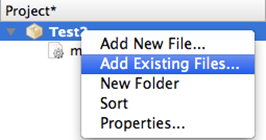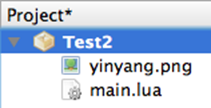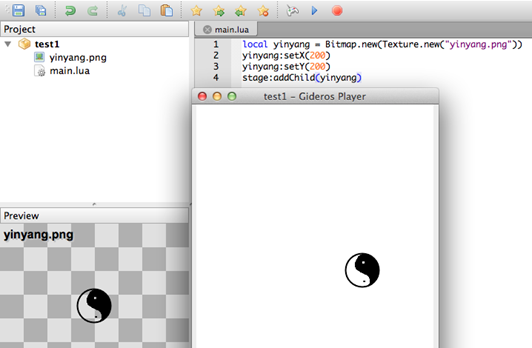Difference between revisions of "Article Tutorials/Drawing Bitmaps"
(update?) |
m (Text replacement - "<source" to "<syntaxhighlight") |
||
| Line 17: | Line 17: | ||
In your main.lua: | In your main.lua: | ||
| − | < | + | <syntaxhighlight lang="lua"> |
local yinyang = Bitmap.new(Texture.new("yinyang.png")) | local yinyang = Bitmap.new(Texture.new("yinyang.png")) | ||
yinyang:setX(200) | yinyang:setX(200) | ||
| Line 55: | Line 55: | ||
== Sprite Group == | == Sprite Group == | ||
You can add a few images to a Sprite group object, then all transformation done on the group will propagate to its children: | You can add a few images to a Sprite group object, then all transformation done on the group will propagate to its children: | ||
| − | < | + | <syntaxhighlight lang="lua"> |
spritegroup = Sprite.new() | spritegroup = Sprite.new() | ||
spritegroup:setPosition(100,100) | spritegroup:setPosition(100,100) | ||
Revision as of 17:53, 12 July 2023
Displaying Images
First we need to add images to our project:
Right-click Files and select Link existing files from the menu:
Add in an image you’ve created or downloaded from the internet:
You can copy my yinyang image from here:
Now we can display this image on the screen.
In your main.lua: <syntaxhighlight lang="lua"> local yinyang = Bitmap.new(Texture.new("yinyang.png")) yinyang:setX(200) yinyang:setY(200) stage:addChild(yinyang) </source>
Launch the Player and press the Play button to see the result:
You can also use SetPosition:
yinyang:setPosition(210, 220)
Now set the size (scale) of the image. X-scale to ½ the width and Y-scale to twice the height:
yingyang:setScale(0.5, 2)
You can flip your image horizontally or vertically in code to save creating separate images for each direction:
yingyang:setScaleX(-1)
yingyang:setScaleY(-1)
Change your image rotation angle:
yinyang:setRotation(45)
Fade your image. This sets its transparency:
yinyang:setAlpha(0.5) Alpha can be anywhere from 0 to 1
You can also make your image totally disappear without removing it from the stage:
yinyang:setVisible( false )
When you’re finished with your image, don’t forget to remove it from the stage so it won’t take up memory and processor:
stage:removeChild(yinyang)
Remove your image from memory totally:
yinyang = nil
Sprite Group
You can add a few images to a Sprite group object, then all transformation done on the group will propagate to its children: <syntaxhighlight lang="lua"> spritegroup = Sprite.new() spritegroup:setPosition(100,100) local yinyang = Bitmap.new(Texture.new("yinyang.png")) yinyang:setPosition(10,10) spritegroup:addChild(yinyang) local yinyang2 = Bitmap.new(Texture.new("yinyang.png")) yinyang2:setPosition(100,100) spritegroup:addChild(yinyang2) stage:addChild(spritegroup) </source>
Set all images in the Sprite group to half transparency:
spritegroup:setAlpha(0.5)
Rotate the Sprite group to rotate all images:
spritegroup:setRotation(45)
Note: this tutorial was written by Jason Oakley and was originally available at: http://bluebilby.com/2013/04/14/gideros-mobile-tutorial-displaying-images.


